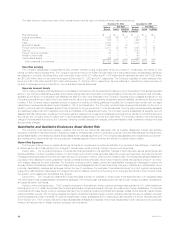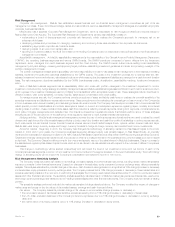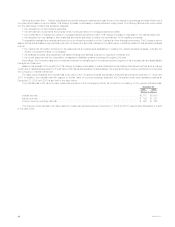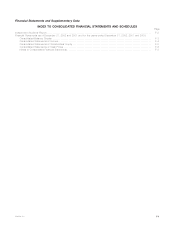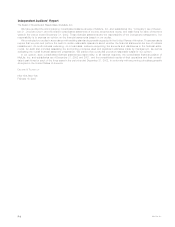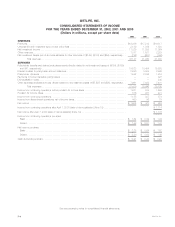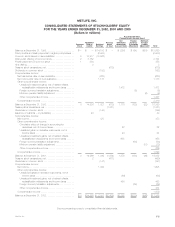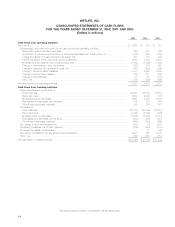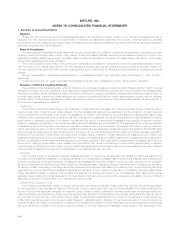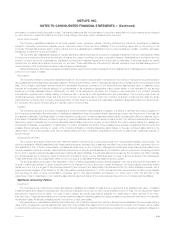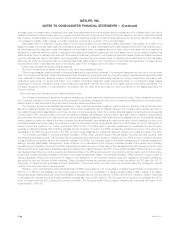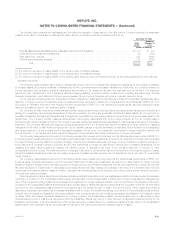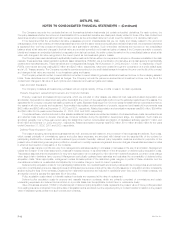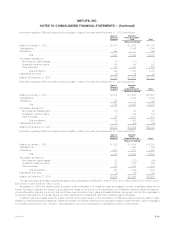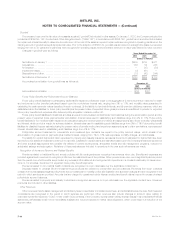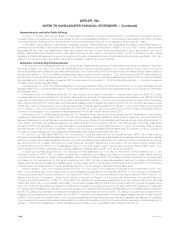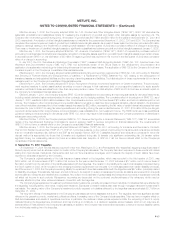MetLife 2002 Annual Report Download - page 52
Download and view the complete annual report
Please find page 52 of the 2002 MetLife annual report below. You can navigate through the pages in the report by either clicking on the pages listed below, or by using the keyword search tool below to find specific information within the annual report.METLIFE, INC.
NOTES TO CONSOLIDATED FINANCIAL STATEMENTS
1. Summary of Accounting Policies
Business
MetLife, Inc. (the ‘‘Holding Company’’) and its subsidiaries (together with the Holding Company, ‘‘MetLife’’ or the ‘‘Company’’) is a leading provider of
insurance and other financial services to a broad section of individual and institutional customers. The Company offers life insurance, annuities,
automobile and property insurance and mutual funds to individuals and group insurance, reinsurance, as well as retirement and savings products and
services to corporations and other institutions.
Basis of Presentation
The accompanying consolidated financial statements include the accounts of the Holding Company and its subsidiaries, partnerships and joint
ventures in which the Company has a majority voting interest. Closed block assets, liabilities, revenues and expenses are combined on a line by line
basis with the assets, liabilities, revenues and expenses outside the closed block based on the nature of the particular item. See Note 7. Intercompany
accounts and transactions have been eliminated.
The Company uses the equity method of accounting for investments in real estate joint ventures and other limited partnership interests in which it
has more than a minor interest, has influence over the partnership’s operating and financial policies and does not have a controlling interest. The
Company uses the cost method for minor interest investments and when it has virtually no influence over the partnership’s operating and financial
policies.
Minority interest related to consolidated entities included in other liabilities was $491 million and $442 million at December 31, 2002 and 2001,
respectively.
Certain amounts in the prior years’ consolidated financial statements have been reclassified to conform with the 2002 presentation.
Summary of Critical Accounting Estimates
The preparation of financial statements in conformity with accounting principles generally accepted in the United States of America (‘‘GAAP’’) requires
management to adopt accounting policies and make estimates and assumptions that affect amounts reported in the consolidated financial statements.
The critical accounting policies, estimates and related judgments underlying the Company’s consolidated financial statements are summarized below. In
applying these policies, management makes subjective and complex judgments that frequently require estimates about matters that are inherently
uncertain. Many of these policies, estimates and related judgments are common in the insurance and financial services industries; others are specific to
the Company’s businesses and operations.
Investments
The Company’s principal investments are in fixed maturities, mortgage loans and real estate, all of which are exposed to three primary sources of
investment risk: credit, interest rate and market valuation. The financial statement risks are those associated with the recognition of impairments and
income, as well as the determination of fair values. The assessment of whether impairments have occurred is based on management’s case-by-case
evaluation of the underlying reasons for the decline in fair value. Management considers a wide range of factors about the security issuer and uses its
best judgment in evaluating the cause of the decline in the estimated fair value of the security and in assessing the prospects for near-term recovery.
Inherent in management’s evaluation of the security are assumptions and estimates about the operations of the issuer and its future earnings potential.
Considerations used by the Company in the impairment evaluation process include, but are not limited to: (i) the length of time and the extent to which the
market value has been below amortized cost; (ii) the potential for impairments of securities when the issuer is experiencing significant financial difficulties;
(iii) the potential for impairments in an entire industry sector or sub-sector; (iv) the potential for impairments in certain economically depressed geographic
locations; (v) the potential for impairments of securities where the issuer, series of issuers or industry has suffered a catastrophic type of loss or has
exhausted natural resources; and (vi) other subjective factors, including concentrations and information obtained from regulators and rating agencies. In
addition, the earnings on certain investments are dependent upon market conditions, which could result in prepayments and changes in amounts to be
earned due to changing interest rates or equity markets. The determination of fair values in the absence of quoted market values is based on valuation
methodologies, securities the Company deems to be comparable and assumptions deemed appropriate given the circumstances. The use of different
methodologies and assumptions may have a material effect on the estimated fair value amounts.
Derivatives
The Company enters into freestanding derivative transactions primarily to manage the risk associated with variability in cash flows related to the
Company’s financial assets and liabilities or to changing fair values. The Company also purchases investment securities and issues certain insurance and
reinsurance policies with embedded derivatives. The associated financial statement risk is the volatility in net income, which can result from (i) changes in
fair value of derivatives not qualifying as accounting hedges, and (ii) ineffectiveness of designated hedges in an environment of changing interest rates or
fair values. In addition, accounting for derivatives is complex, as evidenced by significant authoritative interpretations of the primary accounting standards
which continue to evolve, as well as the significant judgments and estimates involved in determining fair value in the absence of quoted market values.
These estimates are based on valuation methodologies and assumptions deemed appropriate in the circumstances. Such assumptions include
estimated market volatility and interest rates used in the determination of fair value where quoted market values are not available. The use of different
assumptions may have a material effect on the estimated fair value amounts.
Deferred Policy Acquisition Costs
The Company incurs significant costs in connection with acquiring new insurance business. These costs, which vary with, and are primarily related
to, the production of new business, are deferred. The recovery of such costs is dependent upon the future profitability of the related business. The
amount of future profit is dependent principally on investment returns, mortality, morbidity, persistency, expenses to administer the business, creditworthi-
ness of reinsurance counterparties and certain economic variables, such as inflation. Of these factors, the Company anticipates that investment returns
are most likely to impact the rate of amortization of such costs. The aforementioned factors enter into management’s estimates of gross margins and
profits, which generally are used to amortize such costs. Revisions to estimates result in changes to the amounts expensed in the reporting period in
which the revisions are made and could result in the impairment of the asset and a charge to income if estimated future gross margins and profits are less
than amounts deferred. In addition, the Company utilizes the reversion to the mean assumption, a standard industry practice, in its determination of the
F-8


